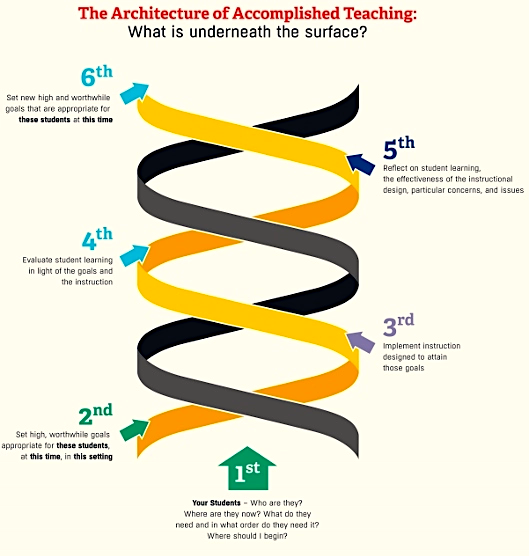Lifting My Students Out of the Math Fact Fog
By Kathleen Palmieri

I notice it when students are demonstrating a basic understanding of how to use the steps in a math problem, yet some use repeated addition or get confused when using multiples and then make computation errors that result in frustration or the inability to solve the problem.
I’ve also realized that a few of my students have been flying below my radar as they have perfected the “blend in with the group” technique – rather than asking their own questions when they truly don’t understand.
After reflecting on my students’ learning, the effectiveness of the flow of instruction, and my concerns, I hit the brakes and made some changes in my math instruction.
Getting started
The first step in making these changes was to take a long pause and think about my students. I reflected upon where they are now in math, what they need, and the order in which they need it.
This is actually the first step in the National Board for Professional Teaching Standards’ Architecture of Accomplished Teaching: “Your Students – Who are they? Where are they now? What do they need and in what order do they need it? Where should I begin?”
This is a resource that embodies the “Five Core Propositions”* and is part of the National Board journey, as well as one that I believe is an important tool when I plan instruction.
While following a curriculum map is important to ensure all concepts are covered in the time frame needed, as an educator I must recalibrate my plans when necessary to meet each of my students’ needs to help them become confident, successful learners.
In my opinion – and based on my experiences and research – the very foundation of good instruction is knowing my students and using my observations, formative assessments, and quite honestly, my gut feelings to guide my instruction.
Hearing from students
One thing I needed to know is what each of them actually knew – their “prior knowledge.” I held a math class meeting. I started with a “where we’ve been” approach to learning over the past few math topics, asking students to share their thoughts. The only part of this class meeting that I regret is that I didn’t do it sooner.
Students not only shared what they learned, but also where they realized they needed more practice. Turns out, if you ask for students’ thoughts, they will share! What came next was a class action plan that included postponing the upcoming topic test and spending a week with activities to help strengthen three key areas:
1. Breaking down word problems and sharing strategies
2. Division practice
3. Math fact activities
Finally, I met with each of my fifth graders individually for what we named a “Math Check In.” During this time the student shared how they are feeling about math, and I gave them a division problem to work through. I listened and watched for their process, ease of math fact recall, and how they checked the quotient. Then together we set individual goals that would help that student at that particular time in math.
Putting student ideas into practice
The week that followed was energizing, engaging, and exciting. Here is a snapshot of activities:
► Partner work solving word problems.
► Using the C.U.E.S. strategy to analyze a math word problem for understanding (Circle the question, Underline important words and numbers, Eliminate extra information, and Solve).
► Working around the classroom using large pieces of paper to try to solve division problems in different ways: partial quotients, area models, long division, etc. Using multiplication to check quotients.
► Card games: Each partner flips a card and takes turns multiplying the factors together.
► Using Prodigy for online fact practice/problem solving.
► Using Flip to create videos to share strategies/teach a concept/share a math trick.
► Creating digital flashcards using Flippity for math fact practice
In addition to the activities, the class came up with topics to use as discussion starters during activities:
► Talk strategy – there is more than one way to solve a math problem.
► Share strategies – standard algorithm, long division, area models.
► Use logic, estimation techniques such as compatible numbers; rounding rules to see if your solution is reasonable.
► Question, check, solve.
► Decimal division – place value; whole numbers – understand the decimal point is to the right of the whole number.
► Decrease the numbers value when you divide.
► Increase the numbers value when you multiply.
Student change
During our week of activities my students looked forward to math time, and they jumped right into the rotation with focus and smiles. They felt in charge of their learning, which made them want to succeed as this was their plan.
When it came time for the topic test, the students demonstrated confidence and focus. They were ready, determined and took the test with a new awareness of their math skills. The results were amazing as students were working toward their own personal best.
I highly recommend hitting the brakes, taking time to clear the fog, and talking as a class to make a math action plan. You’ll be glad that you did!
Image: JohnInNC
Kathleen Palmieri is a National Board Certified Teacher and NBCT Professional Learning facilitator. She is a fifth grade educator in upstate New York who reviews and writes regularly for MiddleWeb. With a passion for literacy and learning in the classroom, she participates in various writing workshops, curriculum writing endeavors, and math presentations.
As a lifelong learner, Kathie is an avid reader and researcher of educational practices and techniques. She enjoys collaborating with colleagues and globally on Twitter and expanding her education adventures at www.kathleenpalmieri.com.







































I love this post! My school has worked hard on fact fluency for years. Without it, that “math fog” is tough to clear.
Thank you, Rita. Yes, the math fog is tough to clear. Fact fluency and keeping math skills sharp is necessary as students move into new concepts.